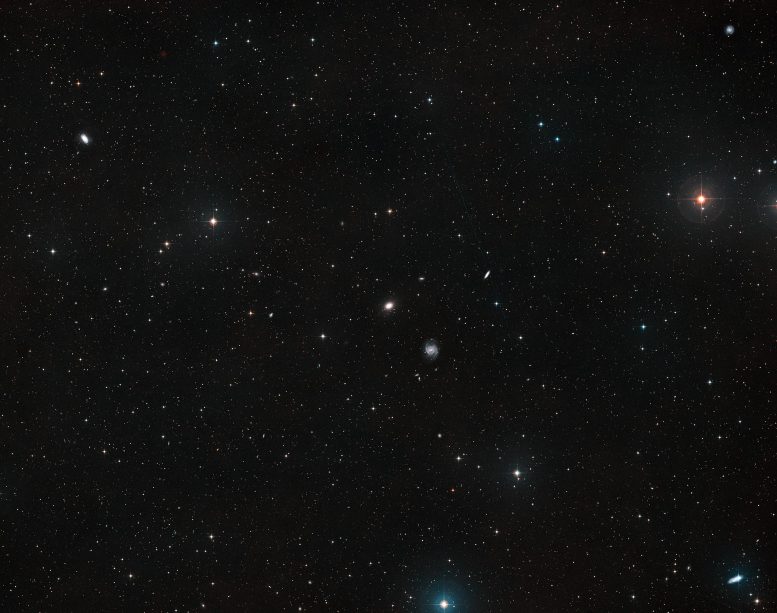
New data from the NASA/ESA Hubble Space Telescope provides further evidence for tidal disruption in the galaxy NGC 1052-DF4. This result explains a previous finding that this galaxy is missing most of its dark matter. By studying the galaxy’s light and globular cluster distribution, astronomers have concluded that the gravitational forces of the neighboring galaxy NGC 1035 stripped the dark matter from NGC 1052-DF4 and are now tearing the galaxy apart. This image, created from images forming part of the Digitized Sky Survey 2, shows the sky around NGC 1052-DF4. Credit: ESA/Hubble, NASA, Digitized Sky Survey 2; Acknowledgment: Davide de Martin
In 2018 an international team of researchers using the NASA/ESA Hubble Space Telescope and several other observatories uncovered, for the first time, a galaxy in our cosmic neighborhood that is missing most of its dark matter. This discovery of the galaxy NGC 1052-DF2 was a surprise to astronomers, as it was understood that dark matter is a key constituent in current models of galaxy formation and evolution. In fact, without the presence of dark matter, the primordial gas would lack enough gravitational pull to start collapsing and forming new galaxies. A year later, another galaxy that misses dark matter was discovered, NGC 1052-DF4, which further triggered intense debates among astronomers about the nature of these objects.
Now, new Hubble data have been used to explain the reason behind the missing dark matter in NGC 1052-DF4, which resides 45 million light-years away. Mireia Montes of the University of New South Wales in Australia led an international team of astronomers to study the galaxy using deep optical imaging. They discovered that the missing dark matter can be explained by the effects of tidal disruption. The gravity forces of the neighboring massive galaxy NGC 1035 are tearing NGC 1052-DF4 apart. During this process, the dark matter is removed, while the stars feel the effects of the interaction with another galaxy at a later stage.
Until now, the removal of dark matter in this way has remained hidden from astronomers as it can only be observed using extremely deep images that can reveal extremely faint features. “We used Hubble in two ways to discover that NGC 1052-DF4 is experiencing an interaction,” explained Montes. “This includes studying the galaxy’s light and the galaxy’s distribution of globular clusters.”
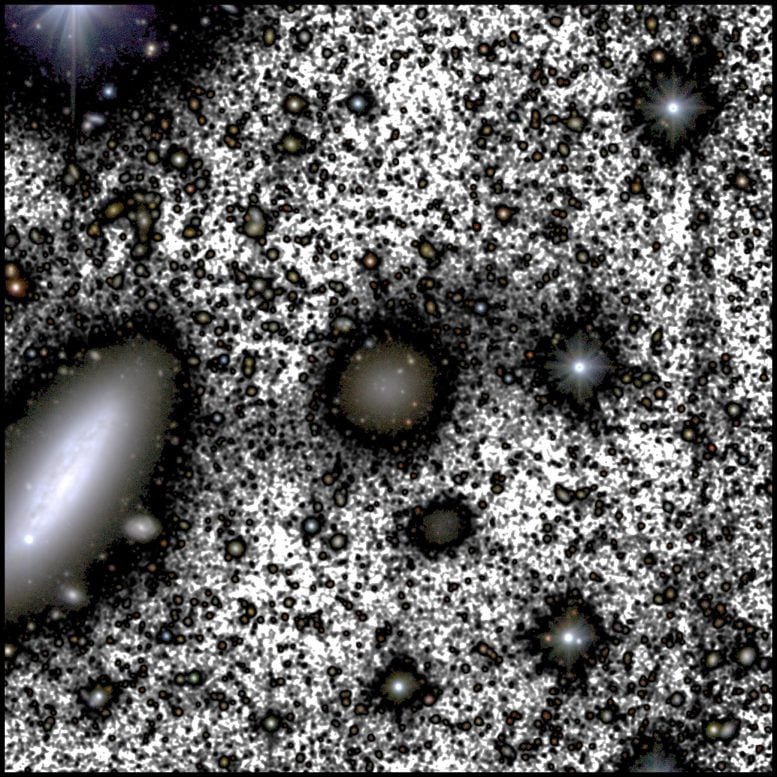
This image presents the region around the galaxy NGC 1052-DF4, taken by the IAC80 telescope at the Teide Observatory in Tenerife, Spain. The figure highlights the main galaxies in the field of view, including NGC 1052-DF4 (center of the image) and its neighbor NGC 1035 (center left). Credit: M. Montes et al.
Thanks to Hubble’s high resolution, the astronomers could identify the galaxy’s globular cluster population. The 10.4-meter Gran Telescopio Canarias (GTC) telescope and the IAC80 telescope in the Canary Islands of Spain were also used to complement Hubble’s observations by further studying the data.
“It is not enough just to spend a lot of time observing the object, but a careful treatment of the data is vital,” explained team member Raúl Infante-Sainz of the Instituto de Astrofísica de Canarias in Spain. “It was therefore important that we use not just one telescope/instrument, but several (both ground- and space-based) to conduct this research. With the high resolution of Hubble, we can identify the globular clusters, and then with GTC photometry we obtain the physical properties.”
Globular clusters are thought to form in the episodes of intense star formation that shaped galaxies. Their compact sizes and luminosity make them easily observable, and they are therefore good tracers of the properties of their host galaxy. In this way, by studying and characterizing the spatial distribution of the clusters in NGC 1052-DF4, astronomers can develop insight into the present state of the galaxy itself. The alignment of these clusters suggests they are being “stripped” from their host galaxy, and this supports the conclusion that tidal disruption is occurring.
By studying the galaxy’s light, the astronomers also found evidence of tidal tails, which are formed of material moving away from NGC 1052-DF4. This further supports the conclusion that this is a disruption event. Additional analysis concluded that the central parts of the galaxy remain untouched and only about 7% of the stellar mass of the galaxy is hosted in these tidal tails. This means that dark matter, which is less concentrated than stars, was previously and preferentially stripped from the galaxy, and now the outer stellar component is starting to be stripped as well.
“This result is a good indicator that, while the dark matter of the galaxy was evaporated from the system, the stars are only now starting to suffer the disruption mechanism,” explained team member Ignacio Trujillo of the Instituto de Astrofísica de Canarias in Spain. “In time, NGC 1052-DF4 will be cannibalized by the large system around NGC 1035, with at least some of their stars floating free in deep space.”
The discovery of evidence to support the mechanism of tidal disruption as the explanation for the galaxy’s missing dark matter has not only solved an astronomical conundrum, but has also brought a sigh of relief to astronomers. Without it, scientists would be faced with having to revise our understanding of the laws of gravity.
“This discovery reconciles existing knowledge of how galaxies form and evolve with the most favorable cosmological model,” added Montes.

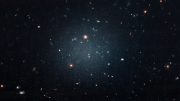
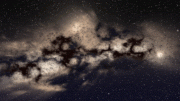
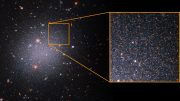
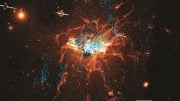
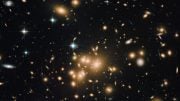
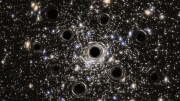


Scientists tend to find evidence for the things they are looking for. The problem is that there may be something wrong with the observations themselves due to something distorted in space-time between us and the galaxy or object we’re observing. That distortion may be due to the shape of the Universe itself, perhaps affected by other Universes or unknown anomalies around it that alter the shape of space-time. In other words, like a funhouse mirror, what if the galaxies we’re observing are actually normal sized for our current calculations of Einstein predicted macro physics, but only appear to be the wrong size due to distortion effects between us and the object. We’re already aware of gravitational lensing, but we don’t expect outside “objects” (like another Universe or overlapping unseen dimensions that might be “out of phase” somehow with our own, but still weakly interacts) to be causing distortions in the vast tracts of space-time.
The problem with assumptions of “dark matter” or “dark energy” rather than actual mechanisms at play with known physics, but unknown elements beyond our ability to view them is that it leads to narrowed thinking and worse yet ridicule caused by hubris of human beings that claim to follow “Science” but really enjoy egotistical games of making fun of those that challenge their own “belief” systems of all things theoretical in nature.
A good example is on the medical level with the cause of Alzheimer’s Disease. A man in Australia that dared challenge the notion that Amyloid plaques are the “cause” of the disease, but perhaps were a mere side effect of say an infection involving something as common as Herpes was continually denied funding to study this possibility for a decade, as funding sources were “certain” they already knew the cause. All studies reducing the plaques have failed utterly to change the course of the disease and only recently have a few allowed for the possibility they may have been wrong all these decades due to observational failure to tell causation from effect. Most still cling to the almost religious belief that the plaques are the cause and if only they could be removed, function would be restored. They now place TIME as the issue rather than disease (ravages of a virus like Herpes or Shingles through the brain setting off an immune response where the plaques are actually anti-viral or anti-bacterial in nature as some testing has shown, but unable to stop long term damage).
The few that question whether “Dark Matter” or “Dark Energy” are simply misunderstood mechanisms of something we know very little about compared to other forces (i.e. Gravity) and routinely ridiculed and denied funding in the very same way. It’ll be too bad if that deters us from finding the real answers to gravity (and thus possible benefits like creating artificial anti-gravity forces) for decades or even centuries due to nothing but stubborn human hubris to consider other possibilities rather than sticking all resources to one study.
How well is the Big Bang theory holding up after all these decades? Some are beginning to question whether it truly encompasses all that we see and that perhaps localized bursts (possibly due to colliding membranes of bubble Universes themselves) cause “Mini-Big Bangs” rather than Universal sized ones. But they get ridiculed and laughed at because we “know” (due to mere red shift alone) that there definitely was a “big bang” that caused EVERYTHING. Indeed. What caused the anomaly to “explode” in the first place? Why/How was it unstable? We have NO IDEA. It’s pure observational conjecture just like “Dark Matter” and “Dark Energy” are great math fudges to try and plug a theoretical leak rather than to even begin to consider perhaps the pipe wasn’t all that well built in the first place.
Begin laughter now. You know you want to laugh. It’s human nature to comfort oneself than seriously consider anything new and even “scientists” are far from immune to our lower nature.
There could be problems with the science – the paper describes some that they mitigate or wish to improve on – but the remaining uncertainty (> 5 sigma quality) is low enough to make it a discovery in peer review publication.
Dark matter have not been an assumption for almost a century now [“Dark matter” @ Wikipedia]. “The first to suggest the existence of dark matter using stellar velocities was Dutch astronomer Jacobus Kapteyn in 1922.” Both dark matter and dark energy can be observe by many independent means by now. But perhaps the simplest method, which anyone can use, is to observe it in the cosmic background spectra [“The Genome of the Universe” @ Galileo’s Pendulum; “Secrets of the Cosmic Microwave Background” @ PBS Space Time youtube].
The overall cosmology stands up well – the Planck collaboration 2018 and eBOSS collaboration 2020 agree – but your description doesn’t. Our current cosmology of inflationary hot big bang [“The Big Bang is Probably Not What You Think It Is” @ Domain Of Science youtube] is modeled as Lambda-Cold Dark Matter [“Lambda-CDM model” @Wikipedia] for a reason: observed dark matter has been best explained by heavy, gravitationally particles since 2016 [“The Labor of Outflows against Dark Matter Halo” @ astrobites]. Since the “hot big bang” part only applies to our local universe, there is a mainstream theory of eternal inflation – shored up the Planck collaboration 2018 observation of slowroll inflation which naturally is such. They are not “ridiculed” as much as was vocally opposed when the new cosmology was initially proposed. However, the eBOSS collaboration 2020 shortlists Weinberg’s “anthropic multiverse” in their cosmology paper as an explanation for the observed vacuum energy density, so it is starting to be seriously embraced.
We have a very good idea why the slowroll inflation locally stopped and its field energy became converted to a hot big bang [The Big Bang is Probably Not What You Think It Is” @ Domain Of Science youtube; note that it doesn’ describe mechanisms: mechanism explanation in “What Happened Before the Big Bang” @ PBS Space Time youtube].
So in the end you have non-supported claims, some good question if you want to formulate them such – see the putative inflationary multiverse physics above – and to that you add a science illiterate conspiracy theory on how it and its experts work.
And at posting an odd ad pops up. I hope it is just my browser – adding ads in comment thread is something new, I reported that.
Even ads during commenting now, oy!
I wanted to add that I see several misspellings et cetera in my longer comment – too many but small to add an errata on – so I guess it’s time to take a break.
From the paper:
“Smith et al. (2013, 2016) used numerical simulations to explore the effect of tidal stripping in the DM content of dwarf galaxies in clusters of galaxies. They found that only when the remaining DM fraction falls under 10−15% is when the stars and GCs of the galaxy are significantly stripped.”
“Taking the current estimate of the total dynamical mass measured in vD19, the average remaining fraction of DM of <= 1%. However, the dynamical mass-to-light ratios of isolated UDGs vary widely (e.g., Toloba et al. 2018; M¨uller et al. 2020) affecting our estimate of the initial total mass of the galaxy. So, the remaining DM fraction could be as high as 10%. This is consistent with the simulations in Smith et al. (2013, 2016). … the mass stripping of DM haloes proceeds gradually from the outside in … In NGC1052-DF4, the fraction of stellar mass in the tidal tails is ∼ 7% (Sec. 4.6), meaning that the bound stellar mass is 93%, in contrast with the <= 1% of DM still bound to the galaxy."
I looked at the 2016 simulation reference, and it looks like they use effective dark matter particles that emulate the observed density in their hydrodynamic simulations. So it won't tell much on dark matter particles other properties.